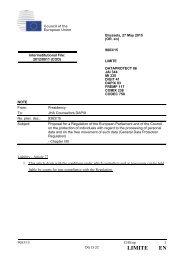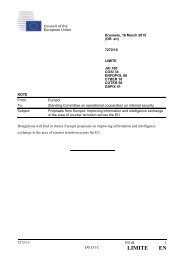National Security Information Handbook
epa-nsi-handbook-2012
epa-nsi-handbook-2012
Create successful ePaper yourself
Turn your PDF publications into a flip-book with our unique Google optimized e-Paper software.
NSI <strong>Handbook</strong><br />
<strong>Security</strong> Classification<br />
5. An OCA with jurisdiction over the information may change the level of classification<br />
of information. Documents shall be remarked with the new classification level, the<br />
date of the action, and the authority for the change. Changing the classification level<br />
may also require changing portion markings for information contained within a<br />
document. Additionally, the OCA shall update appropriate security classification<br />
guides.<br />
2-208 <strong>Security</strong> Classification Guides<br />
1. Originators of classification guides should consult users for input when developing or<br />
updating guides. When possible, originators of classification guides should<br />
communicate within their agencies and with other agencies that are developing<br />
guidelines for similar activities to ensure consistency and uniformity of classification<br />
decisions. The NSI Program Team will provide a template for classification guides,<br />
and will maintain a list of all classification guides in use within EPA.<br />
2. Original classification decisions shall be incorporated into a classification guide.<br />
3. <strong>Security</strong> classification guides shall:<br />
Identify the subject matter of the classification guide<br />
Identify the OCA by name and position, or personal identifier;<br />
Identify an agency point-of-contact or points-of-contact for questions regarding<br />
the classification guide<br />
Provide the date of issuance or last review<br />
State precisely the elements of information to be protected<br />
State which classification level applies to each element of information, and, when<br />
useful, specify the elements of information that are unclassified<br />
State, when applicable, special handling caveats<br />
State a concise reason for classification<br />
Prescribe a specific date or event for declassification<br />
4. The Subject Matter Expert (SME) from the program office or facility is responsible<br />
for development of the security classification guide. The guide must be submitted in<br />
final draft form to the NSI Program Team to ensure compliance with E.O. 13526.<br />
The NSI Program Team will forward the final draft to EPA's Office of Homeland<br />
<strong>Security</strong> for review and processing for approval by the OCA.<br />
5. <strong>Security</strong> classification guides will be approved in writing by the OCA authorized to<br />
classify the information. Copies of the guides will be distributed by the originating<br />
organization to those organizations and activities believed to be derivatively<br />
classifying information covered by the guide or have a valid need-to-know. The<br />
original copy of each guide shall be forwarded to the NSI Program Team for<br />
permanent retention.<br />
6. Guides will be revised whenever necessary to promote effective derivative<br />
classification. When a guide is revised, computation of declassification dates will<br />
continue to be based on the date of the original classification decision. All revisions<br />
2-5







